Occupational environment monitoring at the factory producing springs
99,000 ₫
Note: The above price is calculated for one sample, the price may fluctuate depending on the area of the environment to be monitored and the movement of the market. For more accurate price support, please refer to the quotation table or contact directly with our consulting staff.
Environmental monitoring of spring manufacturing factories is a session of collecting, analyzing, and evaluating factors in the workplace that may be harmful to the health of workers.
Table of Contents
Toggle1. Overview of Spring Manufacturing Factories
a. What is a spring manufacturing factory?
A manufacturing factory for springs is a facility that carries out the production process for various types of springs. Springs are important components in many industries, including automotive, household appliances, electronics, healthcare, furniture, and many others. A spring manufacturing factory is equipped with specialized equipment, tools, and production processes to create springs with the required sizes, shapes, and properties for specific applications.

b. Production stages in a spring manufacturing factory
Production stages in a spring manufacturing factory may include:
- Material preparation: Preparing main materials such as steel wire, alloys, or other metal strands.
- Material cutting: Cutting materials into segments of required size and length.
- Spring forming: Bending material segments into the desired spring shape using spring forming machines.
- Heat treatment: Springs may require heat treatment to achieve desired hardness, strength, and elasticity. The heat treatment process may include heating, rapid cooling, or controlled heating.
- Grinding and finishing: Springs may be ground to remove sharp edges and improve surface finish. This process ensures high durability and reduces risk of injury to users.
- Quality inspection: Springs are inspected to ensure compliance with quality standards. Inspections may include checking elasticity, hardness, diameter, and other specifications.
- Packing and transportation: After production and quality inspection, springs are packed and prepared for delivery to customers or the next stage in the supply chain.

c. Types of machinery used in a spring manufacturing factory
In a spring manufacturing factory, several types of machinery are commonly used for production. Some common machines include:
- Spring cutting machines: Used to cut material segments into desired lengths.
- Spring forming machines: Used to bend material segments into the desired spring shapes. These machines can be adjusted to produce springs of various sizes and shapes.
- Heat treatment machines: Used to heat and cool springs to achieve desired elasticity and hardness.
- Spring grinding machines: Used to grind and finish the surfaces of springs. Grinding smooths sharp edges and creates a finished surface.
- Spring testing machines: Used to inspect technical parameters of springs such as elasticity, hardness, and dimensions. These machines ensure spring quality before packing and shipment.
- Packing machines: Used to package springs after production, into boxes, bags, or cartons, depending on customer requirements.

d. Occupational diseases that workers in a spring manufacturing factory may face
Workers in a spring manufacturing factory may encounter certain occupational diseases related to workplace environmental factors and the production process. Common occupational diseases include:
- Respiratory diseases: Workers may be exposed to dust and metal fumes from production. Inhalation can cause issues such as pneumonia, sinusitis, dry cough, difficulty breathing, etc.
- Skin diseases: Contact with metal compounds and materials may lead to dermatitis, itching, redness, and allergic reactions.
- Hearing disorders: Machines in the factory may generate high noise levels affecting workers’ hearing. Long-term exposure can lead to hearing loss and other ear-related issues.
- Musculoskeletal disorders: Tasks involving lifting, moving, or operating heavy machinery can strain or injure the spine and musculoskeletal system.
- Hand and neck disorders: Repetitive operation of machinery and tools can strain hands and neck, potentially causing conditions like carpal tunnel syndrome or tendonitis.

e. Popular types of springs on the market
There are many types of springs used in various industries. Some popular types include:
- Compression springs: The most common type, usually cylindrical, used to generate and release compressive force.
- Extension springs: Typically made from round or flat wire, stretched under tension to generate pulling force.
- Torsion springs: Twisted springs generating torque when force is applied, used in applications such as rolling doors or rotating devices.
- Special-shaped springs: Springs with trapezoidal, helical, conical, square, or other custom shapes designed for specific applications.
2. Overview of Occupational Environment Monitoring Services
a. What is occupational environment monitoring at a spring manufacturing factory?
Occupational environment monitoring (or workplace measurement) at a spring manufacturing factory involves collecting, evaluating, and analyzing environmental indicators at the factory to take timely measures, minimize hazards to workers’ health, and prevent occupational diseases. Monitoring is mandatory for all spring manufacturing factories.
It plays a critical role in protecting and promoting workers’ health because the main resource of any enterprise, directly generating profit, is its workforce. Workers regularly exposed to risks exceeding permissible limits may develop health issues and occupational diseases.
REGISTER FOR OCCUPATIONAL ENVIRONMENT MONITORING SERVICE
b. Nam Viet’s occupational environment monitoring program
Nam Viet’s occupational environment monitoring program is developed by monitoring engineers specializing in occupational safety and environmental protection. The program uses modern methods to monitor air, water, microclimate factors, physical parameters, dust, and more in the workplace. It is essential for ensuring a safe working environment and protecting workers’ health.
Additionally, Nam Viet’s program contributes to researching and developing new solutions to improve workplace environmental quality. With the dedication and professionalism of its experts, Nam Viet’s exclusive monitoring program is a breakthrough in occupational safety and environmental management in Vietnam.

c. Standardization in workplace measurement procedures
Standardization in Nam Viet’s measurement procedures ensures accuracy and reliability. The program follows recognized standards of the Ho Chi Minh City Department of Health. This guarantees reliable data for evaluating the workplace environment and making decisions to protect worker health.
Standardized procedures ensure measurements are performed by highly qualified monitoring specialists, allowing managers to trust results from An Toan Nam Viet and make accurate, valuable decisions.
By applying standardized procedures, Nam Viet demonstrates its commitment to a safe working environment and contributes to improving occupational safety and environmental management in Vietnam.
d. Reporting results of occupational environment monitoring at spring factories
Monitoring results are prepared according to Form No. 04, Appendix III, Decree 44/2016/ND-CP and prepared in two copies: one for the contracting workplace and one retained by the monitoring organization.
Records must be stored indefinitely as required by law.

e. Frequency of occupational environment monitoring according to law
According to Clause 2 of Article 18 of the Law on Occupational Safety and Health 84/2015/QH13, employers must monitor workplace environment factors at least once a year.
f. Deadline for submitting monitoring reports according to law
The deadline is before December 31 each year. Enterprises must submit monitoring results to the local Department of Health where the main office and employees are located.
If there are changes in technology, production processes, or when upgrading factories that may generate new hazards, enterprises must update occupational hygiene records and conduct monitoring accordingly.
g. Penalties for violations of occupational environment monitoring regulations for employers
According to Article 27 of Decree 12/2022/ND-CP dated January 17, 2022, on administrative penalties in labor, social insurance, and Vietnamese workers working abroad under contract:
- Clause 2: Fine of 2,000,000 – 5,000,000 VND for employers who fail to publicly inform workers at the monitoring site immediately after obtaining results.
- Clause 3: Fine of 20,000,000 – 40,000,000 VND for employers who fail to conduct monitoring to control hazards affecting workers’ health according to law.
- Clause 4: Fine of 40,000,000 – 60,000,000 VND for employers who collude with monitoring organizations to commit fraud in monitoring activities, without reaching criminal liability.
3. Harmful Environmental Factors for Workers in Spring Production Factories
Workers in spring production factories may be exposed to several harmful environmental factors. Here are some potential environmental factors that may affect workers in spring production factories:
- Dust and particles: The spring production process can generate dust and particles from materials such as metals and lubricants. Workers exposed to this dust and particles may inhale or come into contact with them through skin and eyes, causing irritation and health damage.
- Chemicals: Some chemicals may be used during spring production, such as lubricants, cleaning agents, and paints. Direct exposure to these chemicals can irritate the skin, eyes, and respiratory system, and in more severe cases, may harm the liver, kidneys, and nervous system.
- Noise: The spring production process can generate high noise from machinery and operating equipment. Continuous and loud noise can cause auditory problems such as hearing loss, tinnitus, and mental health issues.
- Temperature and humidity: The working environment in spring production factories may have high temperatures due to machinery or heat-intensive processes. Additionally, humidity levels may vary at different production stages. Inappropriate temperature and humidity conditions can make work difficult and affect health and comfort.
- Toxins from waste: The spring production process may produce waste and emissions containing harmful compounds such as heavy metals or organic compounds. Exposure to these wastes and emissions can be harmful if not properly controlled and treated.
REGISTER FOR WORKPLACE ENVIRONMENT MONITORING SERVICE
4. Measures to Improve the Working Environment in Spring Production Factories
To improve the working environment in spring production factories and protect workers’ health, the following measures can be applied:
- Ensure ventilation and fan systems: Install effective ventilation systems to provide clean and fresh air in the factory. Use fans and air purifiers to remove dust and particles from the air.
- Use dust extraction systems: Install effective dust extraction systems to remove harmful dust and particles during production. Ensure regular cleaning and maintenance of the dust extraction system for optimal performance.
- Apply noise control measures: Use soundproofing, acoustic insulation, and vibration reduction methods to reduce noise from machinery and equipment in the factory. Provide ear protection devices for workers to safeguard hearing.
- Training and safety supervision: Train staff on occupational safety and work procedures, including proper use of personal protective equipment and safe working methods. Establish monitoring and evaluation procedures to ensure compliance with safety rules.
- Waste management: Handle and dispose of waste from the spring production process according to regulations and environmental standards. Ensure hazardous waste is safely treated and complies with environmental protection rules.
- Periodic inspection and maintenance: Regularly inspect and maintain machinery and equipment in the factory to ensure stable and safe operation.
- Ensure workplace hygiene: Provide hygiene facilities and safe work practices, including drainage systems, personal hygiene measures, and cleanliness protocols in the production area.
- Regularly conduct workplace environment monitoring in factories, collect and analyze harmful factors affecting workers, and adjust to reduce risks and prevent occupational diseases.
5. Benefits of Regular Monitoring of Spring Production Factories
An Toan Nam Viet provides excellent benefits for businesses using workplace environment monitoring services in accordance with Decree 44/2016/ND – CP on managing and controlling harmful factors in the working environment affecting employees.
- Businesses can proactively control harmful factors in workshops or factories.
- Receive consultation and recommendations on measures to reduce harmful factors and improve working environment quality.
- Indirectly protect human resources, a key factor in the company’s development process.
- Reduce the impact of occupational diseases on workers’ health, thereby minimizing future treatment costs.
- Improve workers’ health, leading to better product quality and maintained production output.
- Ensure compliance with labor safety laws and avoid legal risks.
- Enhance credibility and professionalism in all aspects, elevating the company’s brand.
Nam Viet’s environmental monitoring service is a solution to reduce occupational disease risks, contributing to a clean and high-quality working environment.

6. National Workplace Environment Monitoring Center
Workplace Environment Monitoring Center of Nam Viet is a professional unit for supervising and measuring the quality of workplace environments across all provinces in Vietnam. With a team of experienced monitoring specialists, the center uses modern measuring equipment to ensure accuracy and reliability.
In addition to providing monitoring services, the center supports clients in planning, managing, and following up on workplace environmental issues. Following the motto “customer-centric,” the center prioritizes client satisfaction, meets all customer needs, and commits to providing the best solutions for businesses.
REGISTER FOR WORKPLACE ENVIRONMENT MONITORING SERVICE
With investments in technology, equipment, and human resources, Nam Viet’s monitoring center has become one of the reputable units in workplace environment monitoring in Ho Chi Minh City, with the following objectives:
- We always value brand reputation and the quality of our service products.
- We provide clients with the best and most suitable solutions possible.
- Along with a team of experienced Masters and Engineers, committed to protecting the environment and benefiting businesses.
- By choosing Nam Viet Environmental Monitoring, your company will receive professional service from experts in the field and enjoy the best cost advantages.
The workplace environment monitoring process at Nam Viet includes the following basic steps:
- Before conducting monitoring, we ensure that all machinery and equipment are calibrated and adjusted according to legal regulations.
- Carry out the workplace environment monitoring process as committed to the Department of Health.
- Report workplace environment monitoring results honestly to the employer.
- If the monitoring results do not ensure safety for workers, Nam Viet will support corrective solutions and the workplace will implement:
- Implement measures to improve working conditions to minimize the impact of harmful factors and prevent occupational diseases.
- Organize health checks to detect occupational diseases and related illnesses early for employees in unsafe working conditions.
- Provide in-kind compensation to workers according to labor law regulations.

7. Workplace Environment Monitoring Price List
To help businesses conduct workplace environment monitoring professionally and effectively, Nam Viet provides clients with a comprehensive and reasonably priced monitoring service price list.
- Our price list provides detailed information about the costs of the monitoring services we offer, including travel, measurement, analysis, and reporting. Clients can be fully assured of the accuracy and reliability of the monitoring reports we provide.
- We commit to offering competitive and reasonable prices in the market and are always ready to consult and answer any questions about monitoring services promptly and professionally.
- With Nam Viet’s monitoring price list, clients can easily choose service packages that fit their needs. We commit to delivering the highest satisfaction with professional service quality.
No comments yet

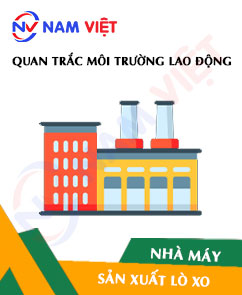
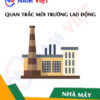
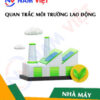

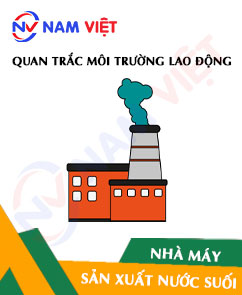
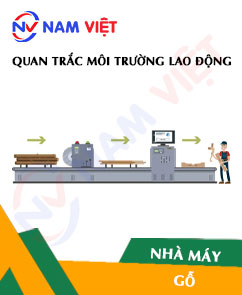


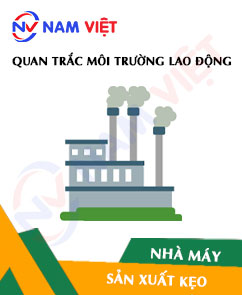

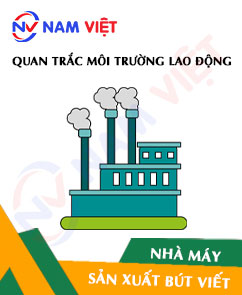
Review Occupational environment monitoring at the factory producing springs
There are no reviews yet.